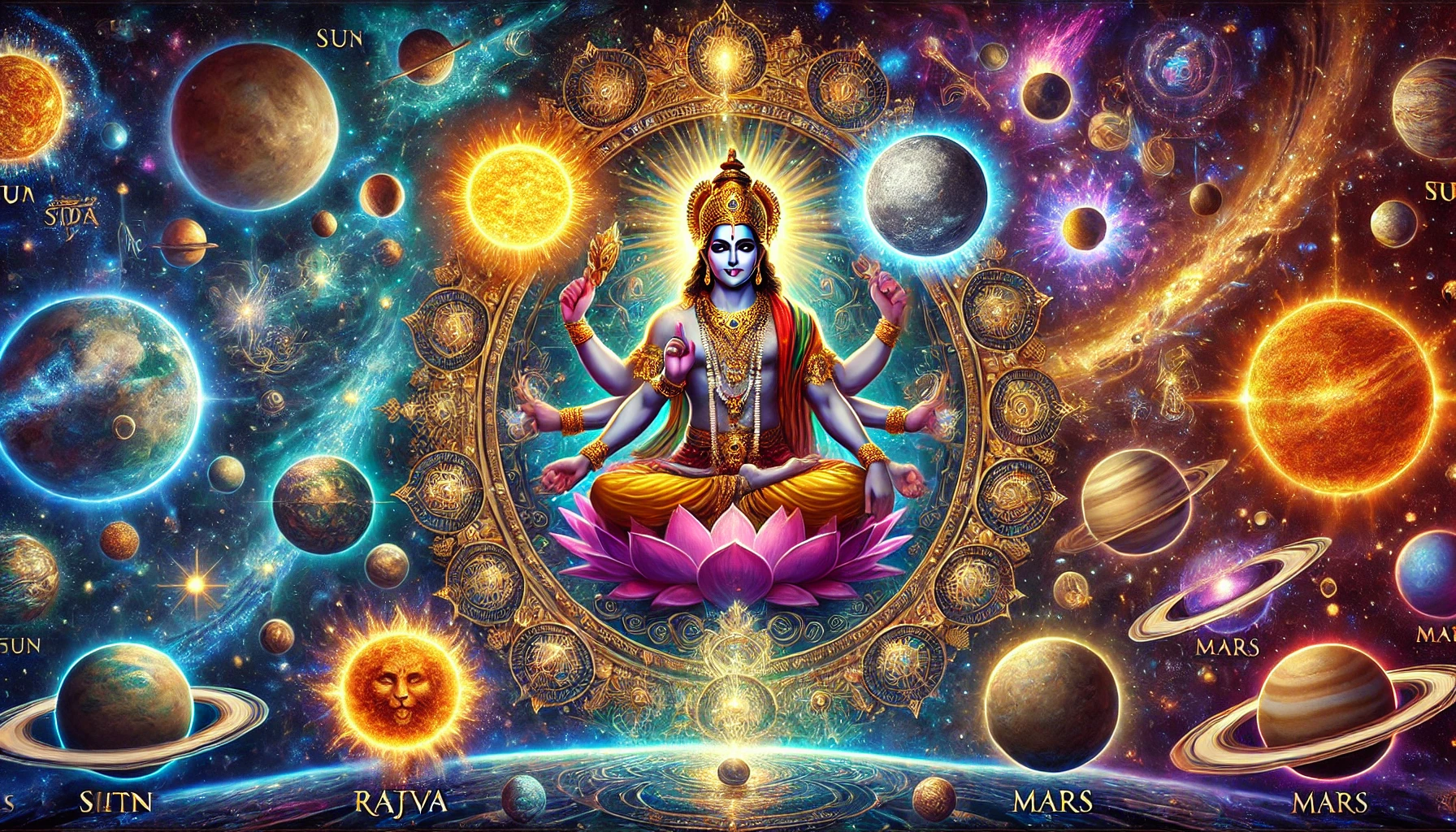Chapter 1: The Creation
1. What is Astrology (Jyotish Shastra)?
Astrology is like a guidebook written by the universe. Just as a clock tells the time or a map helps us find our way, astrology shows how planets, stars, and cosmic energies affect our lives.
Parashara says astrology is part of the Vedas, the oldest books of knowledge. He explains that it helps us understand:
- Who we are (our mind, body, and soul).
- Why things happen (our past karma).
- How we can live better (through remedies and understanding planetary influences).
Example:
Imagine you’re driving a car, and the road has some bumps. Astrology is like a GPS that tells you where the bumps are (challenges in life) and how to avoid or deal with them.
2. Vishnu: The Cosmic Creator
According to Parashara, the universe was created by Lord Vishnu, who is:
- The Creator (Brahma).
- The Sustainer (Vishnu himself).
- The Destroyer (Shiva).
Vishnu works through three qualities:
- Sattva (purity and balance).
- Rajas (activity and passion).
- Tamas (darkness and destruction).
What Does This Mean in Simple Terms?
These qualities (called Gunas) are like different moods:
- When you feel calm and peaceful, that’s Sattva.
- When you’re excited and want to act, that’s Rajas.
- When you feel lazy or destructive, that’s Tamas.
The universe needs all three:
- Creation happens through Rajas.
- Sustaining happens with Sattva.
- Destruction happens through Tamas so new things can begin.
Example:
Think of a garden:
- Planting seeds (creation) needs effort (Rajas).
- Watering and caring for plants (preservation) needs patience (Sattva).
- Removing weeds or old plants (destruction) clears space for new growth (Tamas).
3. Creation from Ahamkara (Cosmic Ego)
What is Ahamkara?
- Ahamkara means “ego” or “I-ness.” It’s the sense of “I exist” or individuality.
- In the universe, Ahamkara is the cosmic ego—like the first step when the universe thought, “I need to exist”.
Vishnu used Ahamkara to divide the universe into three parts:
- Sattvic Ahamkara (pure ego): Created gods and divine beings.
- Rajasic Ahamkara (active ego): Created senses and organs (like eyes, ears, and hands).
- Tamasic Ahamkara (inert ego): Created the five basic elements.
What Are the Five Basic Elements?
Everything in the universe is made of these five elements:
- Earth (Prithvi): Solid things like mountains, bones, and plants.
- Water (Jala): Liquids like rivers, blood, and emotions.
- Fire (Agni): Heat, energy, and transformation.
- Air (Vayu): Wind, breath, and movement.
- Space (Akasha): The empty space where everything exists.
Example:
Think of building a house:
- Tamasic Ahamkara (elements) provides the materials—bricks (earth), water, and space to build.
- Rajasic Ahamkara gives tools like hammers (active senses).
- Sattvic Ahamkara ensures the design is balanced and beautiful.
4. Planets as Divine Energies
Parashara says the planets are not just rocks floating in space. They are divine beings created by Vishnu to guide our lives and deliver the results of our karma.
What Does This Mean?
- Sun (Surya): Represents the soul and vitality. It’s like the light in our life.
- Moon (Chandra): Controls the mind and emotions, like our heart.
- Mars (Mangal): Gives us strength and courage.
- Mercury (Budh): Rules over intelligence and communication.
- Jupiter (Guru): Represents wisdom and spirituality.
- Venus (Shukra): Brings love and beauty.
- Saturn (Shani): Teaches discipline and hard work.
- Rahu and Ketu: Represent our karmic lessons and spiritual growth.
Practical Example:
Imagine the planets are like teachers in school:
- Some are strict (Saturn), while others are kind and inspiring (Jupiter).
- Each teacher (planet) gives us lessons based on how we behaved in previous grades (past karma).
5. Karma and the Role of Planets
Parashara explains that planets are like postmen delivering the results of our actions (karma). They don’t create problems—they only bring what we deserve based on our past lives.
Example:
If you plant apple seeds, you’ll get apples—not mangoes. Similarly:
- Good actions in past lives bring rewards (like good health or wealth).
- Bad actions bring challenges (like delays or losses).
The planets simply make sure we get these results at the right time.
6. Trigunas in Astrology
The three qualities of the universe—Sattva, Rajas, and Tamas—are reflected in the planets:
- Sattva: Jupiter, Sun, and Moon promote purity and spirituality.
- Rajas: Venus and Mercury encourage desires and action.
- Tamas: Saturn, Rahu, and Ketu bring discipline, challenges, and spiritual growth.
Example:
If Saturn (Tamas) is strong in your chart, it might delay success. But it also teaches patience, which is a key life lesson.
7. Why Do We Need Astrology?
Parashara emphasizes that astrology is a tool to:
- Understand our strengths and weaknesses.
- Identify karmic challenges.
- Find remedies to balance planetary influences.
Example:
If someone has Rahu in the 10th house (career), they might face confusion or unexpected changes at work. Remedies like donating food or chanting Rahu’s mantra can reduce its negative effects.
8. Remedies for Planetary Challenges
Parashara stresses the importance of balancing planetary energies through:
- Mantras: Chanting specific sounds to connect with a planet’s energy.
- Example: Chant “Om Namah Shivaya” for Saturn-related issues.
- Charity: Donating items connected to a planet.
- Example: Donate sesame oil or black cloth for Saturn.
- Spiritual Practices: Meditating or fasting on specific days.
- Example: Fast on Thursdays to strengthen Jupiter.

